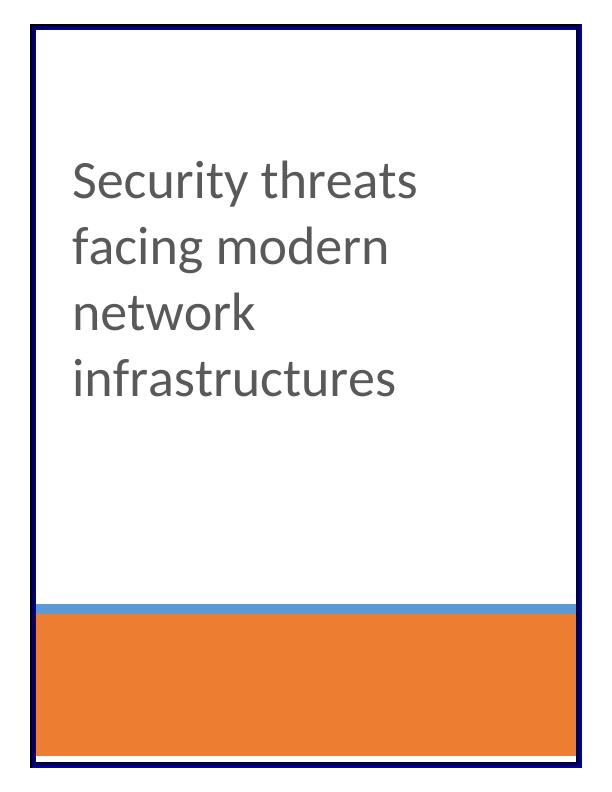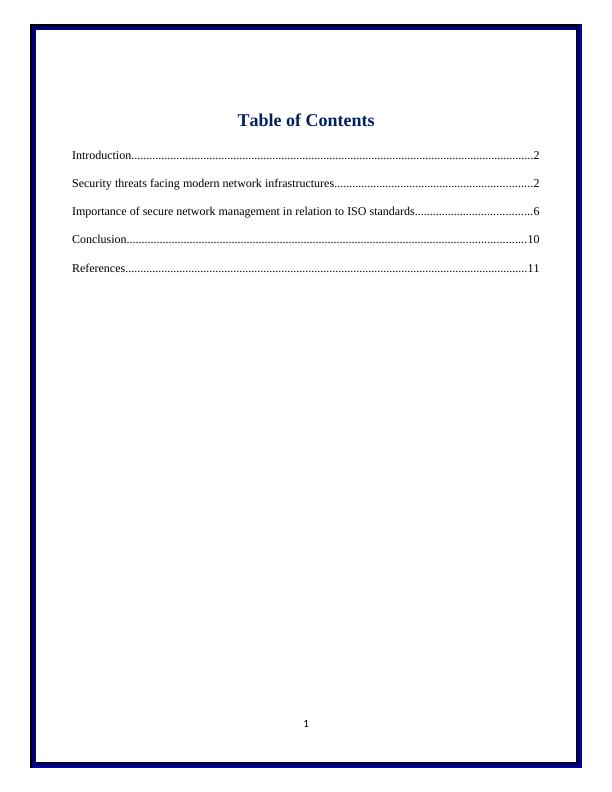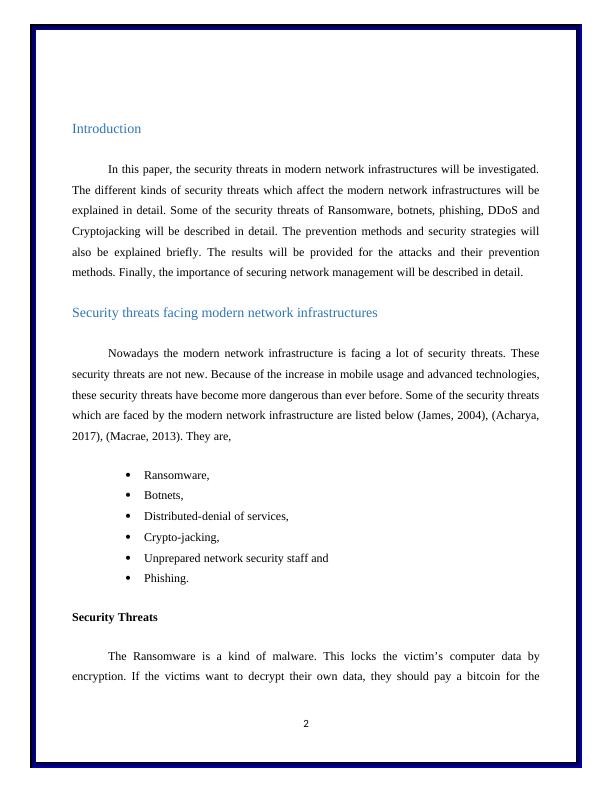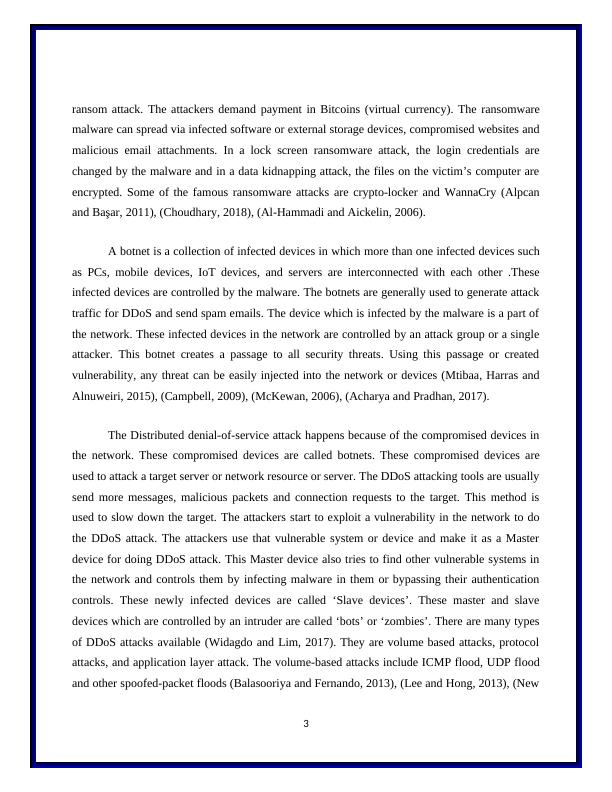Security threats Assignment PDF
Added on 2021-10-08
17 Pages5254 Words133 Views
Security threats
facing modern
network
infrastructures
facing modern
network
infrastructures

Table of Contents
Introduction......................................................................................................................................2
Security threats facing modern network infrastructures..................................................................2
Importance of secure network management in relation to ISO standards.......................................6
Conclusion.....................................................................................................................................10
References......................................................................................................................................11
1
Introduction......................................................................................................................................2
Security threats facing modern network infrastructures..................................................................2
Importance of secure network management in relation to ISO standards.......................................6
Conclusion.....................................................................................................................................10
References......................................................................................................................................11
1

Introduction
In this paper, the security threats in modern network infrastructures will be investigated.
The different kinds of security threats which affect the modern network infrastructures will be
explained in detail. Some of the security threats of Ransomware, botnets, phishing, DDoS and
Cryptojacking will be described in detail. The prevention methods and security strategies will
also be explained briefly. The results will be provided for the attacks and their prevention
methods. Finally, the importance of securing network management will be described in detail.
Security threats facing modern network infrastructures
Nowadays the modern network infrastructure is facing a lot of security threats. These
security threats are not new. Because of the increase in mobile usage and advanced technologies,
these security threats have become more dangerous than ever before. Some of the security threats
which are faced by the modern network infrastructure are listed below (James, 2004), (Acharya,
2017), (Macrae, 2013). They are,
Ransomware,
Botnets,
Distributed-denial of services,
Crypto-jacking,
Unprepared network security staff and
Phishing.
Security Threats
The Ransomware is a kind of malware. This locks the victim’s computer data by
encryption. If the victims want to decrypt their own data, they should pay a bitcoin for the
2
In this paper, the security threats in modern network infrastructures will be investigated.
The different kinds of security threats which affect the modern network infrastructures will be
explained in detail. Some of the security threats of Ransomware, botnets, phishing, DDoS and
Cryptojacking will be described in detail. The prevention methods and security strategies will
also be explained briefly. The results will be provided for the attacks and their prevention
methods. Finally, the importance of securing network management will be described in detail.
Security threats facing modern network infrastructures
Nowadays the modern network infrastructure is facing a lot of security threats. These
security threats are not new. Because of the increase in mobile usage and advanced technologies,
these security threats have become more dangerous than ever before. Some of the security threats
which are faced by the modern network infrastructure are listed below (James, 2004), (Acharya,
2017), (Macrae, 2013). They are,
Ransomware,
Botnets,
Distributed-denial of services,
Crypto-jacking,
Unprepared network security staff and
Phishing.
Security Threats
The Ransomware is a kind of malware. This locks the victim’s computer data by
encryption. If the victims want to decrypt their own data, they should pay a bitcoin for the
2

ransom attack. The attackers demand payment in Bitcoins (virtual currency). The ransomware
malware can spread via infected software or external storage devices, compromised websites and
malicious email attachments. In a lock screen ransomware attack, the login credentials are
changed by the malware and in a data kidnapping attack, the files on the victim’s computer are
encrypted. Some of the famous ransomware attacks are crypto-locker and WannaCry (Alpcan
and Başar, 2011), (Choudhary, 2018), (Al-Hammadi and Aickelin, 2006).
A botnet is a collection of infected devices in which more than one infected devices such
as PCs, mobile devices, IoT devices, and servers are interconnected with each other .These
infected devices are controlled by the malware. The botnets are generally used to generate attack
traffic for DDoS and send spam emails. The device which is infected by the malware is a part of
the network. These infected devices in the network are controlled by an attack group or a single
attacker. This botnet creates a passage to all security threats. Using this passage or created
vulnerability, any threat can be easily injected into the network or devices (Mtibaa, Harras and
Alnuweiri, 2015), (Campbell, 2009), (McKewan, 2006), (Acharya and Pradhan, 2017).
The Distributed denial-of-service attack happens because of the compromised devices in
the network. These compromised devices are called botnets. These compromised devices are
used to attack a target server or network resource or server. The DDoS attacking tools are usually
send more messages, malicious packets and connection requests to the target. This method is
used to slow down the target. The attackers start to exploit a vulnerability in the network to do
the DDoS attack. The attackers use that vulnerable system or device and make it as a Master
device for doing DDoS attack. This Master device also tries to find other vulnerable systems in
the network and controls them by infecting malware in them or bypassing their authentication
controls. These newly infected devices are called ‘Slave devices’. These master and slave
devices which are controlled by an intruder are called ‘bots’ or ‘zombies’. There are many types
of DDoS attacks available (Widagdo and Lim, 2017). They are volume based attacks, protocol
attacks, and application layer attack. The volume-based attacks include ICMP flood, UDP flood
and other spoofed-packet floods (Balasooriya and Fernando, 2013), (Lee and Hong, 2013), (New
3
malware can spread via infected software or external storage devices, compromised websites and
malicious email attachments. In a lock screen ransomware attack, the login credentials are
changed by the malware and in a data kidnapping attack, the files on the victim’s computer are
encrypted. Some of the famous ransomware attacks are crypto-locker and WannaCry (Alpcan
and Başar, 2011), (Choudhary, 2018), (Al-Hammadi and Aickelin, 2006).
A botnet is a collection of infected devices in which more than one infected devices such
as PCs, mobile devices, IoT devices, and servers are interconnected with each other .These
infected devices are controlled by the malware. The botnets are generally used to generate attack
traffic for DDoS and send spam emails. The device which is infected by the malware is a part of
the network. These infected devices in the network are controlled by an attack group or a single
attacker. This botnet creates a passage to all security threats. Using this passage or created
vulnerability, any threat can be easily injected into the network or devices (Mtibaa, Harras and
Alnuweiri, 2015), (Campbell, 2009), (McKewan, 2006), (Acharya and Pradhan, 2017).
The Distributed denial-of-service attack happens because of the compromised devices in
the network. These compromised devices are called botnets. These compromised devices are
used to attack a target server or network resource or server. The DDoS attacking tools are usually
send more messages, malicious packets and connection requests to the target. This method is
used to slow down the target. The attackers start to exploit a vulnerability in the network to do
the DDoS attack. The attackers use that vulnerable system or device and make it as a Master
device for doing DDoS attack. This Master device also tries to find other vulnerable systems in
the network and controls them by infecting malware in them or bypassing their authentication
controls. These newly infected devices are called ‘Slave devices’. These master and slave
devices which are controlled by an intruder are called ‘bots’ or ‘zombies’. There are many types
of DDoS attacks available (Widagdo and Lim, 2017). They are volume based attacks, protocol
attacks, and application layer attack. The volume-based attacks include ICMP flood, UDP flood
and other spoofed-packet floods (Balasooriya and Fernando, 2013), (Lee and Hong, 2013), (New
3

End of preview
Want to access all the pages? Upload your documents or become a member.
Related Documents
Methods to Address Cybersecurity Issues in JL Organizationlg...
|13
|2416
|109
Networking: Malicious Attacks, Social Engineering, Information Security Risks, Network Auditing, and Risk Assessment Managementlg...
|10
|3587
|73
Disaster Recovery Plan - Ransomwarelg...
|4
|1258
|147
Computer Security: DDoS Attackslg...
|11
|2444
|233
DDOS attacklg...
|5
|1194
|491
Extortion Hack: Types, Effects and Prevention Methodslg...
|9
|1842
|92
